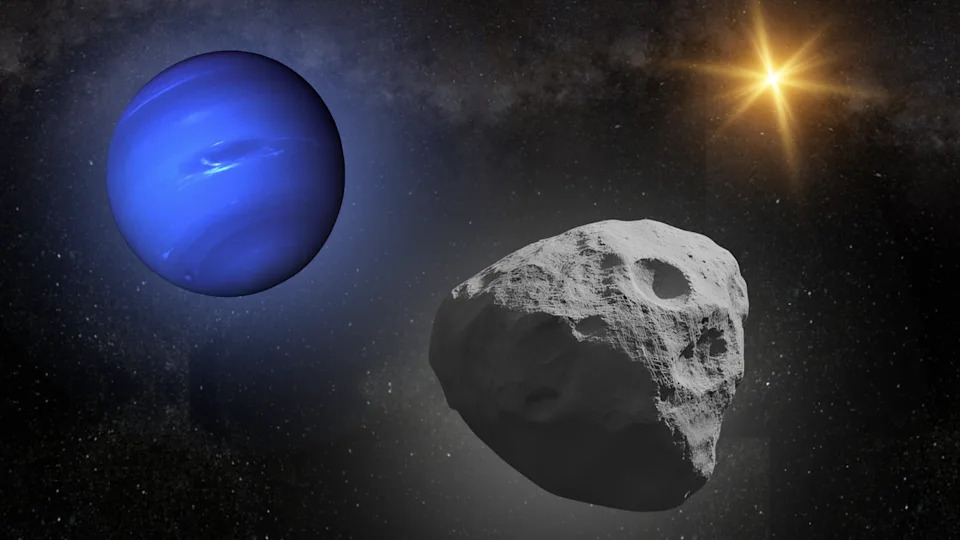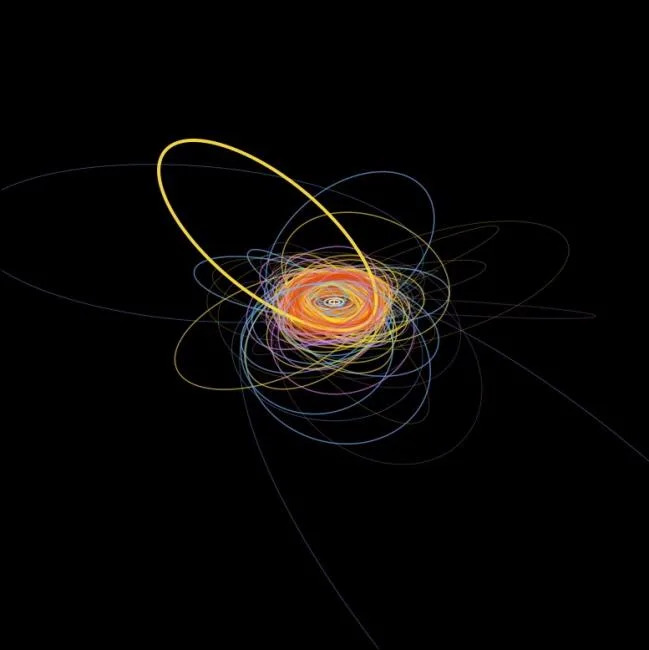Astronomers discover strange solar system body dancing in sync with Neptune: 'Like finding a hidden rhythm in a song'
When you buy through links on our articles, Future and its syndication partners may earn a commission.
 An illustration shows a transneptunian object dancing in harmony with Neptune. | Credit: Robert Lea (created with Canva)
An illustration shows a transneptunian object dancing in harmony with Neptune. | Credit: Robert Lea (created with Canva)Astronomers have found that a weird space rock at the edge of the solar system is locked in a rhythmic dance with Neptune.
The object, designated 2020 VN40, is part of a family of distant solar system objects called trans-Neptunian objects (TNOs). 2020 VN40 is the first object discovered that orbits the sun once for every ten orbits Neptune makes. Considering that one Neptunian year lasts 164.8 Earth years, that means 2020 VN40 has one heck of a long year, lasting around 1,648 years or 19,776 months on Earth!
The team behind this research thinks that 2020 VN40's ponderous orbital dance with Neptune may have come about when it was temporarily snared by the gravity of the ice giant planet. Thus, this discovery could help researchers better understand the dynamics of bodies at the edge of the solar system.
"This is a big step in understanding the outer solar system," team leader Rosemary Pike from the Center for Astrophysics | Harvard & Smithsonian said in a statement. "It shows that even very distant regions influenced by Neptune can contain objects, and it gives us new clues about how the solar system evolved."
The orbital rhythm of 2020 VN40 was discovered in data from the Large inclination Distant Objects (LiDO) survey. LiDO uses the Canada-France-Hawaii Telescope with backup from the Gemini Observatory and the Walter Baade Telescope to search the outer solar system for weird objects.
In particular, LiDO specializes in hunting TNOs with orbits that take them far above and below the orbital plane of Earth around the sun. These are regions of the solar system that have thus far only been sparsely explored by astronomers.
"It has been fascinating to learn how many small bodies in the solar system exist on these very large, very tilted orbits," LiDO team member and University of Regina researcher Samantha Lawler said.
 The orbit of 2020 VN40 as a thick yellow line tilted up and to the left from the orbits of the giant planets Jupiter, Saturn, Uranus and Neptune, represented by the white circles. | Credit: Rosemary Pike, CfA
The orbit of 2020 VN40 as a thick yellow line tilted up and to the left from the orbits of the giant planets Jupiter, Saturn, Uranus and Neptune, represented by the white circles. | Credit: Rosemary Pike, CfAThe highly tilted path of 2020 VN40 finds it at an average distance from the sun equivalent to 140 times the distance between Earth and our star.
However, the most interesting element of the orbit of 2020 VN40 is its resonance with the orbit of Neptune. Other bodies rhythmically aligned with Neptune make their closest approaches to the sun, their perihelion, when Neptune is at its greatest distance from our star, or its aphelion.
Defying this trend, 2020 VN40 is at perihelion when Neptune is also close to the sun. That's if one were looking at it from above the solar system, with the tilt of 2020 VN40 meaning that this TNO and Neptune are not actually close together; the TNO is actually far below the solar system.
This also separates 2020 VN40 from other resonant TNOs, which tend to stay within the plane of the solar system when they make close approaches to the sun.
"This new motion is like finding a hidden rhythm in a song we thought we knew," team member and University of California Santa Cruz scientist Ruth Murray-Clay said. "It could change how we think about the way distant objects move."
Related Stories:
— Astronomers discover a cosmic 'fossil' at the edge of our solar system. Is this bad news for 'Planet 9'?
— Icy asteroids help the James Webb Space Telescope uncover Neptune's history
—Messenger comets might be why Earth has life, asteroid Ryugu samples suggest
Revealing the orbital strangeness of 2020 VN40 suggests that solar system objects with highly tilted orbits can adopt novel and unexpected types of movement.
The hunt is now on for more bodies like 2020 VN40, with the newly operating Vera C. Rubin Observatory set to play a key role in this investigation.
"This is just the beginning," team member and Planetary Science Institute researcher Kathryn Volk said. "We're opening a new window into the solar system's past."
The 2020 VN40 results were published on July 7 in The Planetary Science Journal.
Captivating! The discovery of a celestial dance, where an unusual solar system body synchronizes its movements with Neptune's rhythms—it truly feels like stumbling upon the hidden melody within宇宙的 grandeur.
This fascinating discovery of a celestial body orbiting in perfect sync with Neptune, likening it to finding 'a hidden rhythm within an otherwise invisible melody', truly captivates our imaginations about the intricate choreography among cosmic objects.
The discovery of a strange celestial object in harmony with Neptune is akin to finding an elusive hidden rhythm within the lyrics, echoing through space and piquing curiosity across astronomical circles.
The discovery of a cosmic choreography where an unusual solar system body appears to sync dance with Neptune is nothing short of thrilling – it feels like uncovering the hidden rhythm in Life's soundtrack, reminding us that there are still melodies yet untangled amidst the stars.
This unprecedented discovery of a celestial dance between an unusual solar system body and Neptune, akin to finding that hidden rhythm in every beautiful song—this is astronomy at its most enchanting.
The unexpected synchrony observed between a mysterious solar system body and Neptune is akin to the thrilling discovery of an unseen rhythm within any masterful melody - adding depth, complexity beyond our current comprehension.
The recent discovery of an enigmatic solar system body synchronously orbiting Neptune is akin to uncovering a hidden rhythm within the intricate melody of our cosmic song, revealing new dimensions in astronomical harmonies.
The discovery of a strange solar system body dancing in sync with Neptune echoes the thrill one feels upon stumbling upon hidden rhythms within an enchanting song – revealing any universe's unexpected yet harmonious harmony.
The discovery of an alien solar system body in harmony with Neptune is nothing short of a cosmic serendipity, akin to stumbling upon hidden rhythms within the melody.
This discovery of a strange solar system body dancing synchronously with Neptune is akin to finding that hidden, melodic rhythm in an otherwise obscure song—a serendipitous musical note left untouched by the astronomical canon.
The discovery of a solar system body dancing in sync with Neptune, akin to discovering an exquisite hidden rhythm within the melody—an astounding revelation framing another musical chapter among our cosmic symphony.
The discovery of a mysterious celestial body in harmony with Neptune, dancing to an unseen cosmic rhythm reminiscent 'of finding hidden melodies within the majestic fabric'—it unsettles expectations and awakens fascination for our unknown universe.
The discovery of a celestial body in harmony with Neptune, dancing to an unseen rhythm among the stars - it's akin beaming throughout cosmic space like discovering a hidden gem within our musical universe.
A captivating revelation! This discovery of a celestial body orbiting in harmony with Neptune mirrors the delightful coincidence we might find while delving into an unexpected rhythm within our favorite melody. Like stumbling upon treasure amid cosmic expanses, it's both thrilling and MESMERIZING!
This discovery of a strange solar system body in perfect synchrony with Neptune is like unearthing the hidden rhythm that completes an otherwise melodic puzzle. A truly remarkable cosmic harmony.














